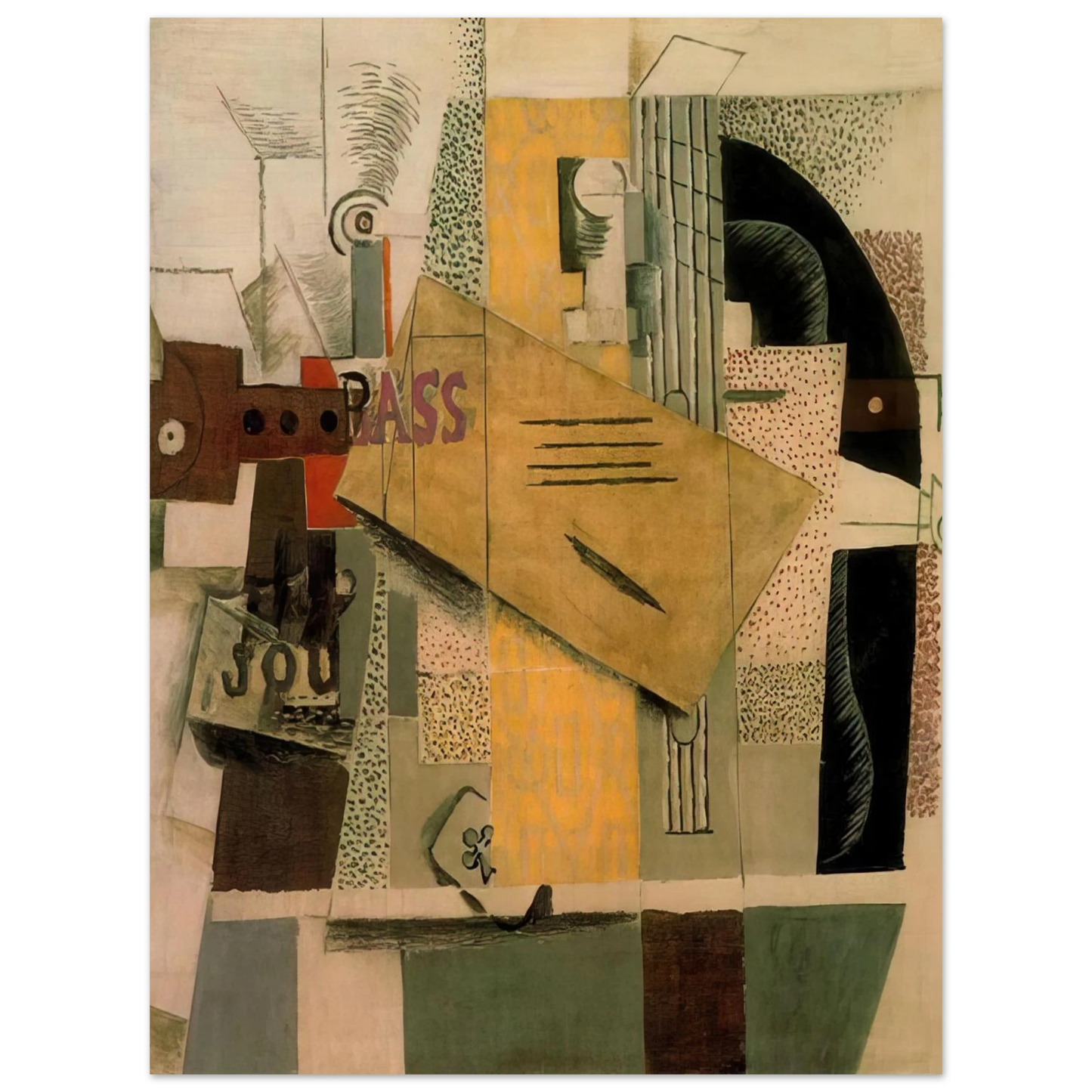RedKalion
Pablo Picasso - Clarinet, bottle of bass, newspaper, ace of clubs - 1913 75x100 cm / 30x40inches Fine Art Poster
Pablo Picasso - Clarinet, bottle of bass, newspaper, ace of clubs - 1913 75x100 cm / 30x40inches Fine Art Poster
Couldn't load pickup availability
Discover more in our: Pablo Picasso Poster Collection
Discover our Fine Art Posters - Iconic artworks with vivid colors using using our fine art 12-color printing technology. Perfect for art lovers and designers alike.
- Color Vibrancy: Our 12-color fine art printing technology delivers vivid, accurate colors with stunning depth, far beyond standard 4-color inkjet printing technology.
- Paper Finishing: Smooth matte finish for a clean, glare-free display.
- Paper Weight: 200 gsm (80 lb), thickness: 0.26 mm (10.3 mils).
- Available Sizes: Offered in a variety of sizes to fit any space or frame.
- Eco-Friendly Materials: Printed on environmentally conscious, FSC-certified paper.
No minimum orders, printed and shipped on demand to guarantee freshness and customization for every order.
Immerse yourself in the revolutionary world of Modern Art with an exquisite fine art poster featuring one of Pablo Picasso's defining Cubist masterpieces: "Clarinet, Bottle of Bass, Newspaper, Ace of Clubs - 1913." This iconic painting, now available as a premium 75x100 cm (30x40 inches) art print, offers a unique opportunity to bring a piece of art history and intellectual brilliance into your home or office. Discover the profound impact of Cubism and the enduring legacy of Picasso through this stunning reproduction, meticulously crafted to capture the original's groundbreaking details and muted palette. Pablo Picasso, a titan of 20th-century art, fundamentally reshaped how artists perceived and represented reality. His development of Cubism, alongside Georges Braque, marked a radical departure from traditional perspective and illusionistic painting. "Clarinet, Bottle of Bass, Newspaper, Ace of Clubs - 1913" stands as a prime example of Analytical Cubism, a phase characterized by its highly fragmented forms, multiple viewpoints, and a near-monochromatic color scheme. Picasso's genius lay in his ability to deconstruct everyday objects, presenting them not as they appear from a single vantage point, but as they are intellectually known and perceived from various angles simultaneously. This analytical approach invited viewers to engage actively with the artwork, piecing together the fragmented forms to construct a more complex and holistic understanding of the subject. In "Clarinet, Bottle of Bass, Newspaper, Ace of Clubs - 1913," Picasso challenges the viewer to decipher a tabletop still life, a common genre he frequently reinterpreted. The title itself provides crucial clues, guiding our eyes through a symphony of broken planes and intersecting lines. The clarinet, a musical instrument often associated with rhythm and sound, is reduced to a series of overlapping cylinders and rectangular sections, its mouthpiece and keys subtly hinted at through careful linear articulation. Its presence introduces a sense of abstract music, a visual melody played out across the canvas. Adjacent to the musical instrument, the bottle of Bass beer is another recurring motif in Cubist works, grounding the abstract composition in a familiar, mundane reality. Here, the bottle's cylindrical form is shattered, its labels perhaps suggested by faint textural differences or the remnants of typography. The inclusion of a newspaper fragment further emphasizes the connection to the everyday world and serves as an early precursor to collage techniques. Bits of text, perhaps headlines or articles, are integrated into the composition, adding a layer of contemporary relevance and a tactile quality that blurs the line between painting and relief. Finally, the ace of clubs, a playing card, introduces an element of chance and human interaction. Its flat, graphic design stands out slightly within the otherwise densely packed composition, a recognizable symbol amidst the abstraction. The playing card also acts as a visual anchor, its clear edges contrasting with the more fluid and ambiguous forms around it. Picasso's masterful use of a restricted palette of grays, browns, and ochres in this period was intentional. By minimizing color, he compelled the viewer to focus entirely on form and structure, on the intricate interplay of light and shadow that defines volume and depth in this new, fragmented space. The shallow pictorial space is densely packed, with objects overlapping and interpenetrating, creating a sense of dynamic tension and intellectual rigor. There is no traditional vanishing point, no clear horizon line; instead, the composition unfolds in a non-hierarchical manner, inviting the eye to wander and discover new relationships between forms. This painting is not merely a representation; it is an exploration of perception itself, a profound philosophical statement on the nature of seeing and knowing. Owning a high-quality fine art poster of "Clarinet, Bottle of Bass, Newspaper, Ace of Clubs - 1913" means more than just acquiring a decorative item. It is an investment in cultural appreciation, a daily invitation to ponder the genius of one of history's most influential artists. This 75x100 cm (30x40 inches) poster is printed using advanced giclée techniques and archival inks on premium, heavyweight paper, ensuring exceptional color fidelity and longevity. Every brushstroke, every subtle shift in tone, and every fragmented plane of Picasso's original work is faithfully reproduced, allowing you to experience the rich texture and intellectual depth of Analytical Cubism in your own space. This Pablo Picasso art print is an ideal choice for art collectors, students of modern art, or anyone looking to infuse their environment with sophistication and artistic intrigue. It serves as an excellent focal point in a living room, a thought-provoking addition to an office, or an inspiring piece for an art studio. Furthermore, it makes an unforgettable gift for art enthusiasts, commemorating Picasso's pivotal role in shaping the trajectory of 20th-century art. Experience the power of Cubism, the revolutionary vision of Pablo Picasso, and the timeless appeal of a true masterpiece with this exquisite fine art poster, designed to inspire and captivate for years to come. Elevate your home decor and celebrate the enduring legacy of a groundbreaking artist.
Share

